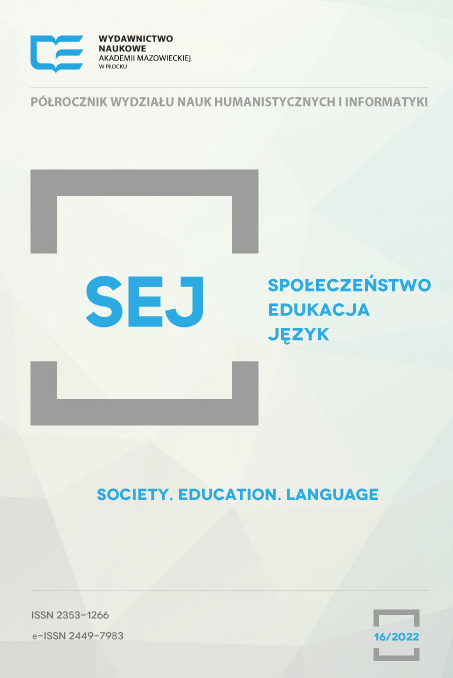THE FACES OF SUFFERING. CHILDREN IN THE NARRATIVE LINE OF EXHIBITION AT THE RIGA GHETTO AND HOLOCAUST IN LATVIA MUSEUM
DOI:
https://doi.org/10.19251/sej/2022.16(18)Keywords:
Holocaust, historical museum, children, Latvia, Riga, museologyAbstract
The author analyses the permanent exhibition devoted to the Holocaust at the Riga Ghetto and Holocaust in Latvia Museum. He uses the methods of visual studies (composition, content, material objects and meanings) and tries to find out what the place of the youngest victims of the Holocaust is in the narrative line of the exhibition. He asks whether there are separate elements of the permanent exhibition devoted to them or the children's fates are “inscribed” in the general message about the events documented there. Are the creators of the museum focused on the tragic dimension of children's fates or do they present them through the prism of heroic deeds showing the individuals who performed them? And finally – is there a place to present the Survivors? The research, the results of which are presented in the paper, is also an aim to answer whether the narrative line of the museum is devoted to specific individuals or to a community of anonymous participants of war events.
References
About. Dostęp: 6.04.2022. http://www.rgm.lv/about/?lang=en
A boyhood stolen by Nazis. Dostęp: 5.05.2022. http://www.rgm.lv/strauss/?lang=en
A child from the city where wind is born. Dostęp: 5.05.2022. http://www.rgm.lv/schwab/?lang=en
Gajda, Kinga Anna. 2019. Edukacyjna rola muzeum. Kraków: Nomos.
Grieving Mother. Dostęp: 26.04.2022. https://www.ebrejumuzejs.lv/en/virtuals_exibitions/serojosa-mate/
Lumans, Valdis O. 2006. Latvia in World War II. New York: Fordham University Press.
Makarova, Elena i Sergei Makarov. 2014. 3000 Fates. The Deportation of Jews from the Terezin Ghetto to Riga. 1942. Riga: Society „Shamir”.
Maza Kalnu Iela House. Dostęp: 19.04.2022. http://www.rgm.lv/about/?lang=en
Memoirs. Dostęp: 23.04.2022. https://www.nli.org.il/en/books/NNL_ALEPH002618332/NLI
Press, Bernhard. 2000, The Murder of the Jews in Latvia: 1941-1945. Evanstone: Northwestern University Press.
Riga Ghetto museum is now open. Dostęp: 19.04.2022. http://www.rgm.lv/museum_is_opened/?lang=en
Riga, the Bikernieki forest. Dostęp: 20.04.2022. http://memorialplaces.lu.lv/memorial-places/riga-and-riga-district/riga-the-bikernieki-forest/
Rose, Gilian. 2010. Interpretacja materiałów wizualnych. Krytyczna metodologia badań nad wizualnością. Warszawa: Wydawnictwo Naukowe PWN.
Rumbula. Dostęp: 20.04.2022. https://www.yadvashem.org/odot_pdf/Microsoft%20Word%20-%205838.pdf
Smirin, Grigory. 2008. The Holocaust in Riga. In: Extermination of the Jews in Latvia 1941-1945. Series of lectures, ed. Menachem Barkahan, 70-98. Riga: Society „Shamir”.
Snyder, Timothy. 2015. Czarna ziemia. Holokaust jako ostrzeżenie. Kraków: Znak Horyzont.
Spungina, Elena. 2008. Jewish Latvia. Brief Guide Book. Riga: Latvian Council of Jewish Communities.
The German Occupation and the First Aktionen in Liepāja. Dostęp: 20.04.2022. https://www.yadvashem.org/yv/en/exhibitions/valley/liepaja/german_occupation.asp
Volkovich, Boris. 2008. Jews in Latvia in the period between the two World Wars (Introductury lecture). In: Extermination of the Jews in Latvia 1941 – 1945. Series of lectures, ed. Menachem Barkahan, 5-35. Riga: Society „Shamir”.
Winstone, Martin. 2017. Miejsca Holokaustu w Europie. Warszawa: Bellona.
Zalmanovich, Miiam. 2008. The Holocaust of Latvian Jewry (An Overview). In: Extermination of the Jews in Latvia 1941-1945. Series of lectures, ed. Menachem Barkahan, 36-69. Riga: Society „Shamir”.
Zisere, Bella. 2013, The Transformation of Holocaust Memory in Post-Soviet Latvia, In: Bringing the Dark Past to Light: The Reception of the Holocaust in Postcommunist Europe, eds. John-Paul Himka and Beata Michlic, 300-318. Lincoln – London: University of Nebraska Press.
